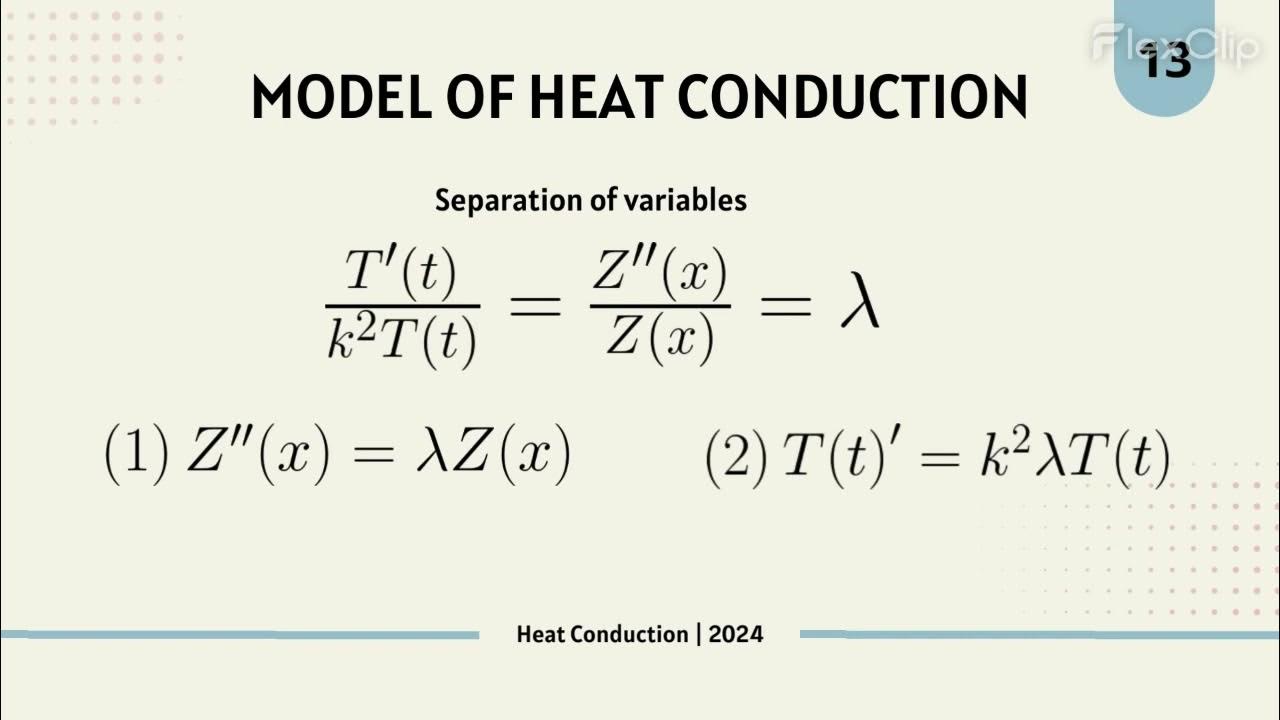Transient Exact and Approximate
Summary
TLDRThis video explains methods for solving transient heat conduction problems, focusing on the time required for a material's temperature to change. Three methods are discussed: Lumped Capacity (valid when Biot number ≤ 0.1), Exact Solution (for Forchheimer number < 0.2), and Approximate Solution (for larger Forchheimer numbers or when exact solutions are overly complex). Through an example involving a steel cylinder in a fluid, the video demonstrates how to calculate Biot number and choose the appropriate solution method, ultimately finding the time for the cylinder's temperature to drop to 350 K as approximately 102.6 seconds using the Approximate Solution.
Takeaways
- 😀 The Lumped Capacity Method is valid when the Biot number is less than or equal to 0.1.
- 😀 The Biot number (Bi) is calculated using the formula Bi = hLc / k, where h is the convective heat transfer coefficient, Lc is the characteristic length, and k is the thermal conductivity.
- 😀 If the Biot number is greater than 0.1, either the exact or approximate solution should be used, depending on the Fourier number.
- 😀 The Fourier number (Fo) helps determine if the exact or approximate solution is more appropriate for a given transient heat conduction problem.
- 😀 The Fourier number is calculated using the formula Fo = αt / Lc², where α is the thermal diffusivity, t is time, and Lc is the characteristic length.
- 😀 For problems with Bi > 0.1 and Fourier number < 0.2, the exact solution is used; otherwise, the approximate solution is chosen.
- 😀 The exact solution involves complex mathematics, including Bessel functions and series expansions, making it difficult for practical applications.
- 😀 Exact solutions are typically used for theoretical understanding, while engineers prefer approximate solutions or numerical methods for practical problems.
- 😀 Approximate solutions are often sufficient for engineering problems, especially when higher-order terms in the series expansion are negligible.
- 😀 Numerical methods like Finite Element Analysis (FEA) and Computational Fluid Dynamics (CFD) are commonly used to solve transient heat conduction problems when exact solutions are too complicated.
Q & A
What is the purpose of solving transient heat conduction problems?
-The purpose is to calculate the time required for a material's temperature to change (either increase or decrease) to a specific target temperature when exposed to a different thermal environment.
What are the three methods commonly used to solve transient heat conduction problems?
-The three methods are: 1) Lumped Capacitance Method, 2) Exact Solution, 3) Approximate Solution.
How is the Biot number calculated, and why is it important?
-The Biot number is calculated as Bi = h * Lc / k, where h is the convective heat transfer coefficient, Lc is the characteristic length, and k is the thermal conductivity. It determines whether the Lumped Capacitance Method is valid (Bi ≤ 0.1).
When is the Lumped Capacitance Method valid for use?
-The Lumped Capacitance Method is valid when the Biot number is less than or equal to 0.1.
What happens if the Biot number is greater than 0.1?
-If the Biot number is greater than 0.1, the Lumped Capacitance Method is not valid, and either the Exact Solution or Approximate Solution should be used instead.
What is the Forster number, and how does it influence the choice between Exact and Approximate solutions?
-The Forster number (Fo) is a dimensionless number that represents the ratio of thermal energy storage to thermal energy conduction. If Fo < 0.2, the Exact Solution can be used; if Fo > 0.2, the Approximate Solution should be used.
What does the Lumped Capacitance Method assume about the temperature distribution within the object?
-The Lumped Capacitance Method assumes that the temperature within the object is uniform, meaning there is no significant temperature gradient within the object.
What is the formula for calculating the Biot number for a cylinder?
-For a cylinder, the characteristic length (Lc) is given by the radius divided by 2 (Lc = r/2). The Biot number is then calculated as Bi = h * Lc / k.
Why are Exact Solutions for transient heat conduction problems often avoided in practice?
-Exact Solutions are avoided because they are mathematically complex, involving series expansions and special functions, which require computational tools. They are not practical for most engineering problems.
What is the typical advantage of using Approximate Solutions over Exact Solutions in engineering practice?
-Approximate Solutions are simpler to compute and are usually accurate enough, especially when higher-order terms in the series have a negligible effect on the results.
What are some modern tools used to solve transient heat conduction problems in place of Exact Solutions?
-Modern tools like Finite Element Analysis (FEA) and Computational Fluid Dynamics (CFD) are widely used to solve complex transient heat conduction problems, providing numerical approximations that are easier to apply in practice.
Outlines

Dieser Bereich ist nur für Premium-Benutzer verfügbar. Bitte führen Sie ein Upgrade durch, um auf diesen Abschnitt zuzugreifen.
Upgrade durchführenMindmap

Dieser Bereich ist nur für Premium-Benutzer verfügbar. Bitte führen Sie ein Upgrade durch, um auf diesen Abschnitt zuzugreifen.
Upgrade durchführenKeywords

Dieser Bereich ist nur für Premium-Benutzer verfügbar. Bitte führen Sie ein Upgrade durch, um auf diesen Abschnitt zuzugreifen.
Upgrade durchführenHighlights

Dieser Bereich ist nur für Premium-Benutzer verfügbar. Bitte führen Sie ein Upgrade durch, um auf diesen Abschnitt zuzugreifen.
Upgrade durchführenTranscripts

Dieser Bereich ist nur für Premium-Benutzer verfügbar. Bitte führen Sie ein Upgrade durch, um auf diesen Abschnitt zuzugreifen.
Upgrade durchführenWeitere ähnliche Videos ansehen

LECTURE NOTES: HEAT TRANSFER, CHAPTER II, PART 2

Understanding Conduction and the Heat Equation

Final report-Thermal Conduction

SUHU, KALOR, DAN PEMUAIAN: IPA SMP KELAS 7

FISIKA KELAS XI | SUHU DAN KALOR (PART 5) - PERPINDAHAN KALOR Konduksi, Konveksi, dan Radiasi

Deriving the Heat Equation: A Parabolic Partial Differential Equation for Heat Energy Conservation
5.0 / 5 (0 votes)
